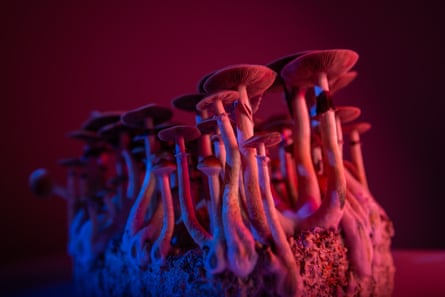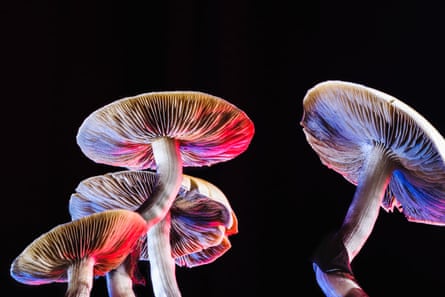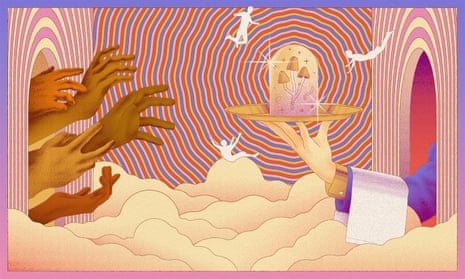The images were massive, mystical and only appeared two hours after Evan had ingested 1.5 grams of magic mushrooms. With his body splayed like a starfish on the hard-packed dirt in his Oakland backyard, he gazed up at the sky as snapshots of his childhood came back to life before his eyes.
Evan’s first mushrooms trip had become a greatest – and worst – hits film reel, during which he relived memories shoved into the deepest caverns of his mind. He grasped at one memory of his 15-year-old self being taunted by a white classmate during a soccer game. “The guy asked me whether my next family reunion was going to be in a prison. I didn’t say anything back at the time,” Evan recalls.
But during his psychedelic hallucination, Evan altered the memory, screaming in his classmate’s face and calling him racist. The moment was “less about yelling ‘screw you, you racist!’” and more about reclaiming power.
Evan, a middle-class Black man, doesn’t come across as a psychedelic enthusiast. He’s a 23-year-old quantitative economics graduate student who takes pride in steaming his sweater vests to maintain a studious appearance. He’s finicky and cautious toward other substances: when he orders wine at restaurants, he asks, “but does this one have any added food coloring?”
In 2015, Evan’s father was arrested for misdemeanor drug possession. A teenager at the time, he swore off drugs forever. But six years later, magic mushrooms have become Evan’s remedy to cope with racial trauma.
Like most Americans, Evan followed the widespread media coverage of George Floyd and Breonna Taylor’s deaths in 2020. And like many Black Americans, he experienced traumatic-stress symptoms triggered by the constant exposure to cases of police brutality and racial discrimination. Debilitating panic attacks incapacitated him multiple times a day; insomnia drained his meager remaining energy.
After unsuccessfully trying three different anti-anxiety medications, he finally stumbled upon a study on psychedelics for racial trauma. He wondered: could psychedelic therapy be the solution?
The last decade has seen the resurgence of the 1960s psychedelic movement, and once-maligned psychedelic substances are now rapidly gaining credibility and popularity. In 2018, the bestselling book How to Change Your Mind by Michael Pollan pushed psychedelic use into the public spotlight, inspiring many skeptics and on-the-fence supporters to take the plunge.
Away from the recreational crowd, patients can now use ketamine nasal sprays in the safety of a doctor’s office to manage treatment-resistant depression. Psilocybin, the active compound in magic mushrooms, has been found to mitigate acute anxiety among patients with life-threatening cancer. A state-sponsored study in Texas is investigating psychedelics as a treatment for post-traumatic stress disorder in veterans.
But one lesser-known benefit has been documented by researchers at the University of Ottawa: psychedelics may alleviate symptoms of race-based traumatic stress.

Evan is a minority within the psychedelic community. The movement skews mostly white and wealthy, with white Americans making up 76% of lifetime psychedelic users while Black Americans report the lowest rates of use.
Reluctance around hallucinogen-based therapy is not unusual in many minority communities, where psychedelic use is associated less with spirituality and more with stigma and arrest. The American war on drugs has made the use of all illicit substances much more dangerous for people of color. Even as decriminalization measures gain traction across the country, psychedelics remain federally illegal while racial disparities in drug arrests linger. So, while white communities deem psychedelics spiritual or avant-garde, minority psychedelic users may face heightened legal risks even if using them for the same purpose.
With a renewed national focus on racial discrimination and an imminent FDA approval of psychedelic therapy for trauma, new pathways for healing are being drawn. But first, the psychedelic community will need to ask how its therapeutic promise can be delivered to all.
Expanding on new therapies like psychedelics, the wife and husband duo Mizan Alkebulan-Abakah and Sizwe Andrews-Abakah seek to redefine healing for communities of color through their Oakland-based organization SPEARITWURX. Together, they host workshops focused on addressing racial trauma’s root causes through a “radical healing model”.
Mizan explains psychedelic-assisted therapy is commonly portrayed as an individual experience – for example, Patient A ingested 20 milligrams of psilocybin, and her depression decreased. This therapeutic model assumes trauma occurs at an individual level, but some mental health conditions – like racial trauma – are group-based by definition. (Although Mizan and Sizwe do not administer psychedelics themselves, participants can acquire substances from psychedelic facilitators and use them during the group’s healing rituals.)
Racial trauma, or race-based traumatic stress (RBTS), is distinct from other forms of post-traumatic stress disorder (PTSD) because patients don’t have to directly experience or witness the stressor to manifest symptoms. Historical oppression and media depictions of racism may trigger trauma symptoms of anxiety, paranoia and severe depression. Because these stressors are shared by entire groups, they may also induce collective trauma.
To address this, Mizan and Sizwe’s Experience Sankofa project combines psychedelic rituals with an immersive timeline of African history. Participants walk through a room of live installations, each section uniquely designed with period-specific tapestries, altars and flooring. In some sections, you’re enveloped in sound: the staticky blare of a black-and-white television or the sultry saxophone bellows of the Harlem Renaissance. In others, SPEARITWURX actors (they call them “activators”) invite you to join in experiential re-enactments.
As you trek through a reconstructed Timbuktu, sandy grits creep into your sandals and crisp eucalyptus incense permeates the room. Passing into the Egyptian temples, silt transforms into smooth cement underneath your feet. Dry hay scratches your toes in the cotton fields. The floor morphs as you travel from the Transatlantic Slave Trade to Black Wall Street to the Black Panthers, culminating in a peak experience with psychedelic facilitators.
Combined with artistic performances and group discussions, the community psychedelic ritual allows you to absorb the “full tapestry of life”: the threads woven between the molecules in a psilocybin mushroom, your pulsating heartbeat, and the imprint of African peoples’ oppression, resistance and aspiration. Mizan and Sizwe emphasize psychedelic therapy must be combined with vulnerable conversations with peers to progress from merely coping to actively resisting racial trauma.
Psychedelic-assisted therapy had been on my mind for months after reading about a ground-breaking clinical trial in Nature Medicine on the use of MDMA, popularly known as ecstasy, as a safe and effective treatment for PTSD. Of the study’s 90 participants, 88% of patients who underwent MDMA-assisted therapy experienced a partial or complete reduction in PTSD symptoms.

While researchers specifically highlighted the applications for PTSD in veterans and child abuse survivors, their findings spotlighted psychedelics as a potential game-changer for race-based traumatic stress, a condition that lacks empirically supported treatments. Despite affecting over 60% of Black Americans, it remains woefully misunderstood.
According to Dr Monnica Williams, who serves as the Canada research chair for mental health disparities at the University of Ottawa, it’s partially because racial trauma is not based on a single traumatic event but on many sources. It’s caused by overt discrimination, like race-based hate crimes, but also by emotional assaults, like “you’re smart for a Black guy,” or the more subtle “but where are you really from?”
In an observational, retrospective study, Williams and her colleagues recruited a group of 313 participants of color from Canada and the US, each of whom had previously taken a psychedelic drug which they said contributed to relief from racial discrimination. Participants recalled the severity of racial trauma symptoms in the month before and after their psychedelic experience, and the researchers found pronounced decreases in traumatic stress, depression and anxiety.
One Black patient described MDMA-induced visions of a sun spinning in the sky like a canary-colored frisbee, with beams unearthing her fear of relying on others. Another patient witnessed herself draped in a lappa, a garment commonly worn in west Africa. The kaleidoscopic fabric billowed as she twirled in a dance circle, and at one point, she flew on the lappa parallel to the clouds, overlooking her ancestors on southern plantations.
Although randomized, placebo-controlled trials are needed to strengthen Williams’s empirical findings, the patient stories gleam with therapeutic innovation and immense hope for healing.
Yet, despite their promises, scientific institutions and federal agencies are unlikely to prioritize racial trauma as a target for psychedelic-assisted therapy, says Rick Doblin, founder and executive director of the Multidisciplinary Association for Psychedelic Studies (MAPS).
Doblin is the type of person who could plan his own surprise party and still be surprised. His innate enthusiasm radiates from his crooked smile when he tells me he likes “to get high on marijuana and strategize with people”. He’s just as sparkling when he describes MDMA’s potential to become an FDA-approved prescription treatment by 2023. But he is less hopeful about accessible psychedelic therapy for racial trauma.
To obtain approval for a new medication, the FDA requires researchers to use the clinician-administered PTSD scale to identify a primary trauma that induced a patient’s traumatic stress. But racial trauma can be the result of a lifetime of events, not just one. And because it doesn’t fit neatly within these guidelines, many patients remain ineligible for clinical trials.
“We actually had some people who were African American with PTSD who failed to qualify for our study because they couldn’t pick one event they would anchor on for all their evaluations,” Doblin says about the patient recruitment process for the MDMA study.

Speaking generally about the current crop of psychedelic studies, Doblin admits with a grimace that “they’re really white”. Non-Hispanic white patients represent more than 80% of participants in large psychedelic studies from the last 30 years.
Doblin offers an explanation for this glaring gap: psychedelic consumption requires patients to make themselves vulnerable, surrendering to the psychedelic experience. Many minorities simply don’t feel safe enough to drop their defenses and take that leap.
In recognition of patient concerns, MAPS kicked off its own MDMA therapy training program and health equity scholarship initiative, giving out $900,000 worth of scholarships to 231 aspiring therapists of color who participate in four-month programs on best practices for MDMA therapy. The hope is to create cohorts of MDMA-assisted therapy practitioners who can support diverse communities.
Each therapist’s cultural background is critical, says Natalie Ginsburg, MAPS’s director of policy and advocacy. When a therapist and a study participant’s cultural backgrounds intersect, the therapist can customize the “trip” setting to maximize a patient’s comfort. Small touches, like the therapist wearing a head wrap or hanging a Black artist’s painting on the wall of the treatment room, can help a minority patient to feel sufficiently comfortable to participate in a study.
Doblin emphasizes that diversifying the psychedelic world requires a thoughtful, equitable approach to research. Ginsburg adds that inclusive clinical studies are only a first step. For psychedelics to become destigmatized in minority communities, the psychedelic community needs “more than that”.
The “more than that” may have to do with plant medicine’s convoluted and divisive history. Long before the psychedelic renaissance of the 2000s, hallucinogenic plant medicines like peyote and ayahuasca were used within Indigenous cultures as early as 10,000 years ago.
Psychedelic history is just as diverse as the psychedelics themselves. The Làngdàng plant, for example, has served as a Chinese herbal for cognitive enhancement and spiritual communication, and Bwiti practitioners in Africa have long taken iboga for religious rituals.
Yet despite centuries of experimentation in minority communities, psychedelics are only now acquiring mainstream credibility. This co-optation of plant medicine has frustrated those like Sandor Iron Rope, the president for the Native American Church of South Dakota and a board member of the Indigenous Peyote Conservation Initiative.
Iron Rope notes that the US Drug Enforcement Administration still classifies peyote as a Schedule I drug, defined as a substance with no accepted medical use and a high potential for abuse. “But it’s not a drug. It’s a medicine. It’s a way of life,” he said.
A lifelong peyote practitioner, he adds that Indigenous cultural healing practices can’t be easily adopted by non-Indigenous psychedelic users. “There is a connection that you can’t read about in a book. There isn’t an ‘on chapter 13 it says, Do this, and I’m connected,’” Iron Rope says. “It is in the blood. It is in the DNA. To move from appropriation to genuine cultural appreciation, we have to center Indigenous perspectives.”
Federally recognized tribes already have legal protections to use peyote for religious purposes. Iron Rope cautions against the broad decriminalization of psychedelics, which will deplete an already diminishing population of peyote. In particular, he fears the commodification of plant medicine will be prioritized over preserving the rights of communities that have used psychedelic plants for centuries, safely and outside of newly emerging systems.
Others disagree, instead advocating for total decriminalization to better serve justice to communities of color. This is the case for Carlos Plazola, the co-founder of Decriminalize Nature, a political initiative that has successfully pushed legislation to decriminalize psychedelics in 15 cities, including Oakland, Detroit and Washington DC.
“I came out of a Chicano Mexican immigrant community, where my cousins who experimented with PCP, heroin or psychedelics went to jail or died from addiction,” Plazola says. “So I originally never gravitated towards psychedelics, even though I spent my whole life, since the age of 12, trying to heal from what I now realize is intergenerational trauma.”
His reflections echo Evan’s sentiments. “I was extremely pissed off when my dad got arrested a second time,” Evan says. After serving one year in county jail for his first offense, Evan’s dad was arrested again in 2017 and charged for felony distribution of controlled substances, including LSD and ecstasy. Evan was 18 years old.
“I guess I hoped … No, I expected things would be different, that he’d try everything he could to stay with our family,” he says. Evan trails off for a few moments. “Maybe my dad did a bad thing, but it’s not that simple. When you’re in a community where the police are who you’re scared of, and prison is made into an expectation, how much of my dad’s sentencing was really from his ‘bad thing’? I can’t think of myself as better than him because I know I won’t ever fully escape the system either.”
After undergoing his first psychedelic trip, Evan often pictured the police sirens coming for his dad, bundles of psychedelic drugs encased in plastic pouches labeled EVIDENCE. Then, he’d think about the plastic baggies of magic mushrooms he stashed in his sweater vest drawer. Although Oakland decriminalized psilocybin in 2019, Evan worried that the crinkled cellophane swaddled in crumpled cashmere would incriminate him next.
One of the exercises Mizan and Sizwe recommend, with or without psychedelics, is the creation of an acrostic poem for the word POWER, each letter and its accompanying word embodying your unique understanding of self-agency.
I introduce the POWER exercise to Evan the next time we meet. “I definitely wouldn’t say P for Psychedelics,” Evan says. “And not just because of the silent P.”
We’re going through the other letters when Evan suddenly says, “My dad is getting out on parole next month.”
The news resurfaced anxieties, although he’d known his father’s early release was a possibility for months.
“Sometimes, I’m scared I’ll scream in my dad’s face when I see him again,” he admits. “And I don’t think 1 gram or 150 pounds of ’shrooms could change that.” Evan looks down at the notepad where he’s been scrawling his acrostic.
“R for Release.” Releasing trauma. Releasing anxiety. And releasing anger, at his dad for leaving, at his white classmates who taunted him with racist jeers, at himself for holding on to the anger in the first place.
Our conversation harkens back to Mizan and Sizwe’s vision for psychedelics and interpersonal healing. Their vision is centered around POWER: O for open conversations. W for welcoming new experiences. E for empathy. Maybe R can be for reform. In any case, the path forward involves more than just “P for Psychedelics”. It needs OWER too.
And what is Evan’s path forward?
“I’m bringing my dad back home,” Evan says. “Then, I can really heal.”
This article was amended on 29 March 2022 to clarify that Mizan and Sizwe do not administer psychedelics themselves.
